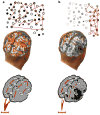Spatial neglect and attention networks
- PMID: 21692662
- PMCID: PMC3790661
- DOI: 10.1146/annurev-neuro-061010-113731
Spatial neglect and attention networks
Abstract
Unilateral spatial neglect is a common neurological syndrome following predominantly right hemisphere injuries and is characterized by both spatial and non-spatial deficits. Core spatial deficits involve mechanisms for saliency coding, spatial attention, and short-term memory and occur in conjunction with nonspatial deficits that involve reorienting, target detection, and arousal/vigilance. We argue that neglect is better explained by the dysfunction of distributed cortical networks for the control of attention than by structural damage of specific brain regions. Ventral lesions in right parietal, temporal, and frontal cortex that cause neglect directly impair nonspatial functions partly mediated by a ventral frontoparietal attention network. Structural damage in ventral cortex also induces physiological abnormalities of task-evoked activity and functional connectivity in a dorsal frontoparietal network that controls spatial attention. The anatomy and right hemisphere dominance of neglect follow from the anatomy and laterality of the ventral regions that interact with the dorsal attention network.
Figures







References
-
- Aron AR, Robbins TW, Poldrack RA. Inhibition and the right inferior frontal cortex. Trends Cogn Sci. 2004;8:170–7. - PubMed
-
- Aston-Jones G, Cohen JD. An integrative theory of locus coeruleus-norepinephrine function: adaptive gain and optimal performance. Annu Rev Neurosci. 2005;28:403–50. - PubMed
-
- Averbeck BB, Latham PE, Pouget A. Neural correlations, population coding and computation. Nat Rev Neurosci. 2006;7:358–66. - PubMed
Publication types
MeSH terms
Grants and funding
LinkOut - more resources
Full Text Sources
Medical

